This family trip to Allahabad-Varanasi-Gaya was undertaken mainly for conducting shraddha ceremony ( a socio-religious ceremony performed for deceased father, grandfather and great grandfather and mother, grandmother and great grandmother) at these three places. It is expected that every Brahmin would visit at least once to Prayag (Allahabad), Varanasi and Gaya in one trip for performing sharddha ceremony for the salvation of the ancestors’ souls. Since the ceremony was required to be conducted in the forenoon, we stayed in our designated maths where these rituals were to be performed. We had afternoon free for doing some sight-seeing before embarking on to our next destinations in the mornings. As we realised later, the afternoon slot for sight-seeing was not sufficient to cover even the important tourist spots as most of these spots used to get closed by 5.00 p.m. In the milieu, we missed going inside Dhamekh Stupa area and the Archaeological Museum at Sarnath. Since I had seen these places in 2000, I have no regret except that I lost opportunity to shoot these places with a digital camera.
The roads in the old city areas of Allahabad and Varanasi were in pathetic conditions. Even Varanasi-Sarnath road which are frequented by international travellers was in bad condition at least halfway. Added to the traffic woes was the cattle population on the road which seems to be competing with pedestrian in every artery road. I even noticed that a few of the cattle shades were right on the road blocking the lane! One can easily get caught in a traffic jam in Allahabad and Varanasi at any time as it happened with us. So we had build in sufficient cushion in planning the journey back to railway stations. Since our journey to the next destination was early mornings, we took hotel rooms near the railway stations for the overnight stays.
A special word about Varanasi. Being a religious city, I always felt that there was nothing much to do here for tourists. My two day’s stay in this city made me realised as to how wrong I was. It is a mind boggling place where spirituality and commercialism coexist side by side. The real Varanasi is hidden behind narrow streets and small alleys. And to get a feel of the real Varanasi, one has to take a long walk through numerous narrow streets and alleys where, pedestrians, cows and two wheelers compete with each other to move on. Each of these narrow alleys has some architecturally superb buildings with their own history. There is a strong possibility that one may get lost in these alleys but I am sure that those who have time and inclination to know more about these alleys, would not mind as this would give them an opportunity to know more about some of the interesting views and subjects to capture in their camera. In any case, those who get lost in the alleys would be pleasantly surprised that they have, at last, made it to one of the numerous ghats at the banks of Ganga.
The pictures uploaded below cover Allahabd-Sarnath-Varanasi with detailed captions on some of the pictures. Photoblog relating to our visit to BodhGaya-Patna-Pawapuri-Rajgir is being constructed separately.
 |
| First halt at Kashi Math, Allahabad. The view of rail bridge on the left and the road bridge on the right from Kashi Math. Allahabad was formerly called as Prayag. It was captured by Mughals in 16th Century and renamed as Allahabad. |
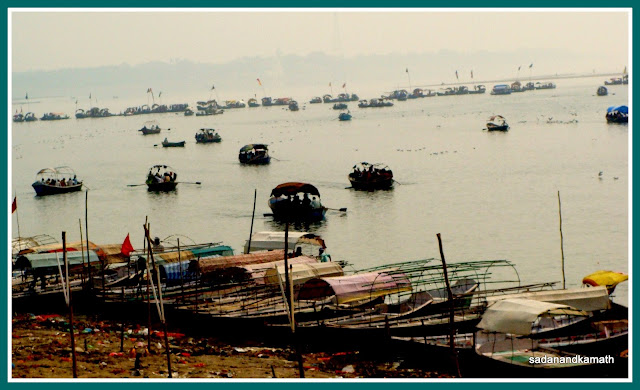 |
| Jetty at Allahabad Fort from where boat rides are to be taken to visit the confluence of Yamuna with Ganga rivers( far end in the background). This is called as Prayag, the place for holy bath during Kumbh Mela. |
 |
| Thousands of migratory seagulls travel from Australia to this place on the onset of winter. This is one of the major attractions of boat rides in Yamuna river during the winter months. In the background is Allahabad Fort. |
 |
| There are constant 'landings' and 'take-offs' of Seagulls in Yamuna river. |
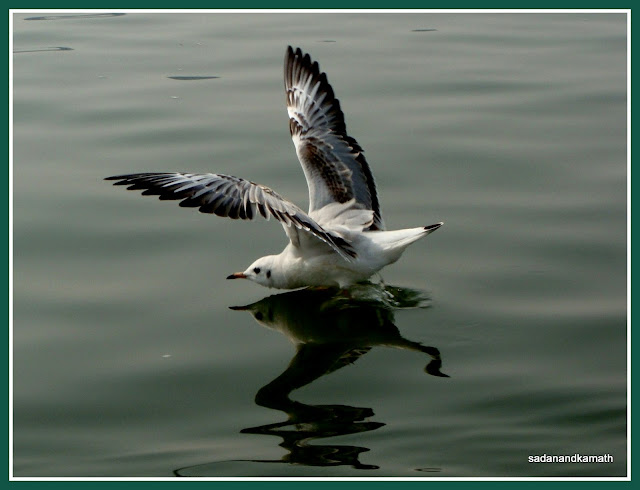 |
| A Seagull 'soft lands' on Yamuna river about to pick up his food. |
 |
| Jetty for boat journey to the confluence of Yamuna river with Ganga river called Prayag. In the background is Allahabad Fort built by Emperor Akbar in 1583. The ramparts of the Fort is covered by creepers. The 3rd century BC Ashok Pillar which was brought from Kausambi has been kept in this Fort which is now a military garrison and not accessible to the public. |
 |
| The confluence. Yamuna river (greenish colour) in the foreground meets Ganga river ( whitish colour) at the spot in the middle with two whirlpools. Actually, it is more like a 'T' junction with Ganga flowing from left to right (top) and Yamuna flowing from down to up direction (bottom). Third river is the mythical Saraswati river which joins Ganga at this spot but is not seen. |
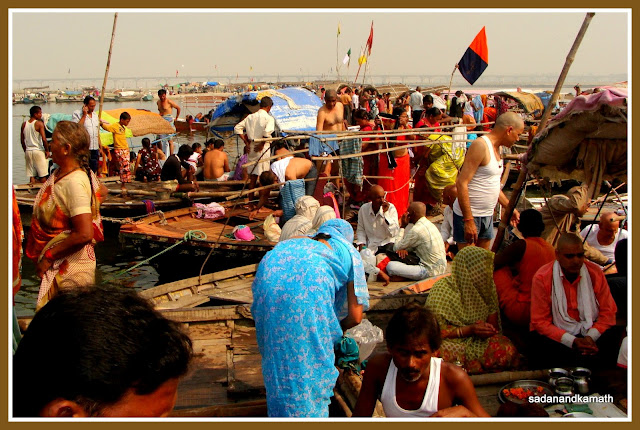 |
| Pilgrims performing rituals on the boats at the confluence of Yamuna and Ganga rivers. Being the Hindu month of Kartik, the pilgrim crowd was quite large lending a great atmosphere of religious fervour. There was a heavy traffic jam of boats putting boatmen to problem in maneuvering their boats from the confluence to the Jetty. |
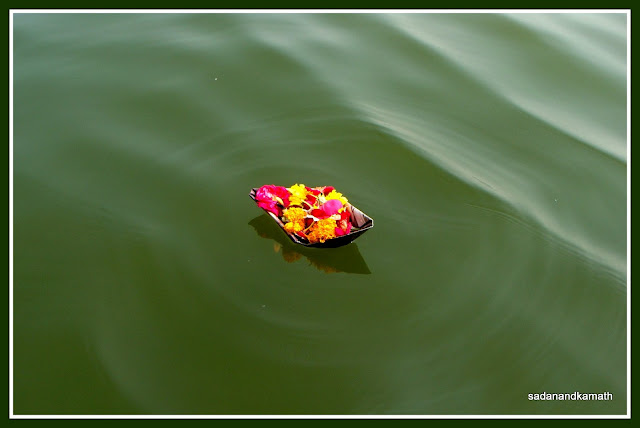 |
| Offering of flowers at the confluence. |
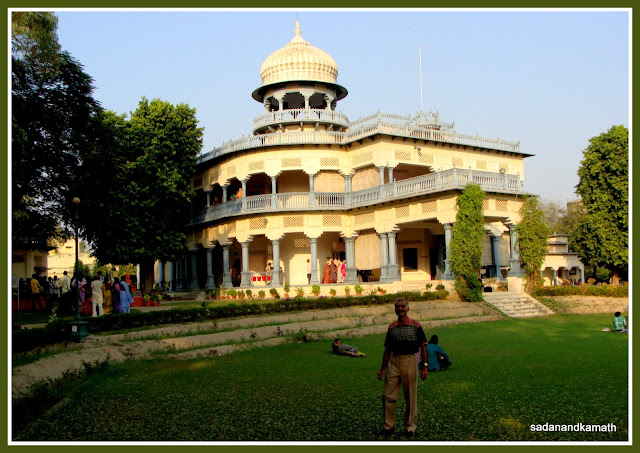 |
| Anand Bhavan, Allahabad. Anand Bhavan was owned by Motilal Nehru, the father of Jawaharlal Nehru in the 19th century. Jawarharlal was born here. It was donated to Government of India in 1970. Now it is a museum managed by Jawaharlal Nehru Memorial Trust. |
 |
| The dome of Anand Bhavan |
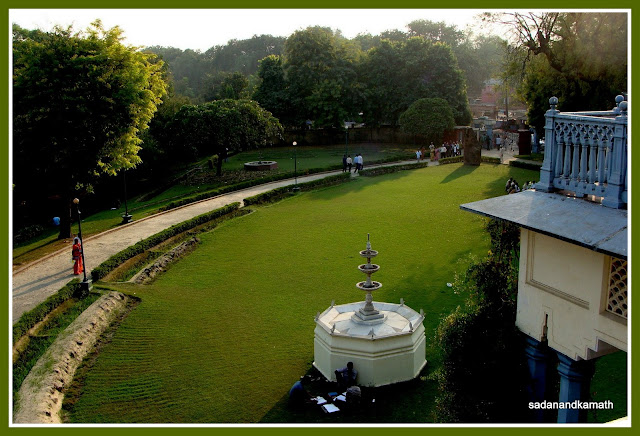 |
| An evening shot of the lawn of Anand Bhavan. |
 |
| Colour portrait of Kamla Nehru, Jawahar Lal Nehru's wife in one of the rooms of Anand Bhavan. |
 |
| One of the rooms in Anand Bhavan where Congress Party's meeting used to take place during the Independent movements. |
 |
| An unusual shape of ceiling fan in one of the rooms of Anand Bhavan |
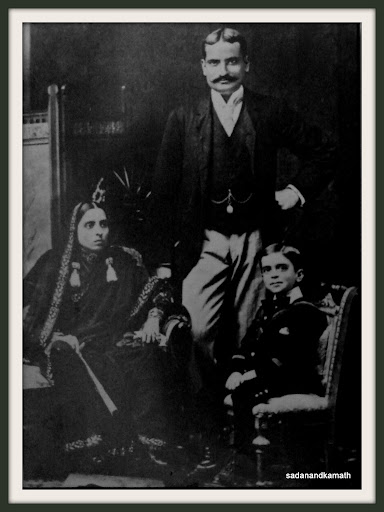 |
| Picture of Motilal Nehru with his wife Swaroop Rani and a young Jawarharlal Nehru in one of the rooms of Anand Bhavan. |
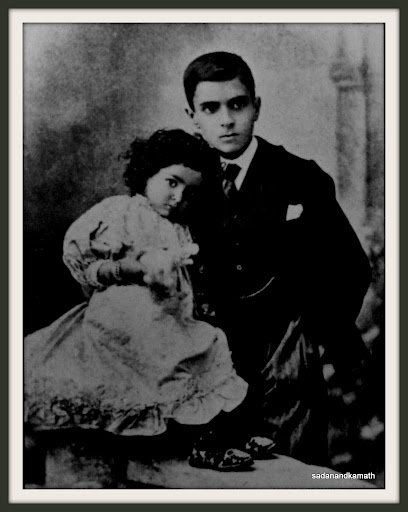 |
| Young Jawaharlal Nehru with his sister Vijaylakshmi Pandit. |
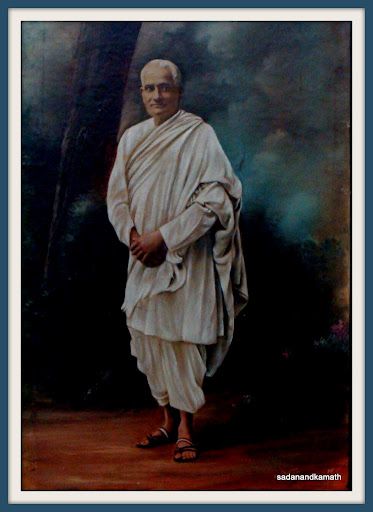 |
| Colour portrait of Motilal Nehru in one of the rooms of Anand Bhavan. |
 |
| Backside view of Anand Bhavan. |
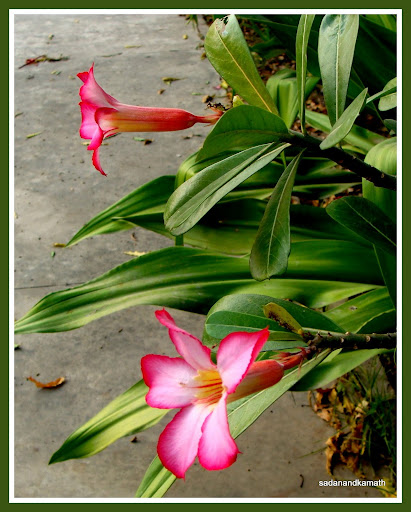 |
| Unidentified flowers in the Anand Bhavan complex. |
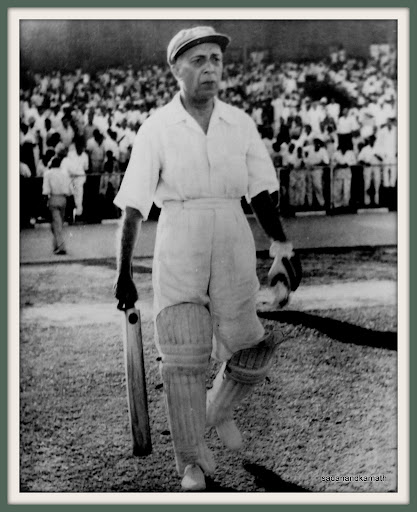 |
| Jawaharlal Nehru in cricketing attire during an exhibition cricket match. Photo displayed in a museum in Anand Bhavan complex. |
 |
| A photo showing Jawaharlal Nehru meeting Albert Einstein at Princeton, New Jersey, USA on November 5, 1949. |
 |
| A photo of Jawaharlal Nehru meeting George Bernard Shaw at Herts, England in May 1949. |
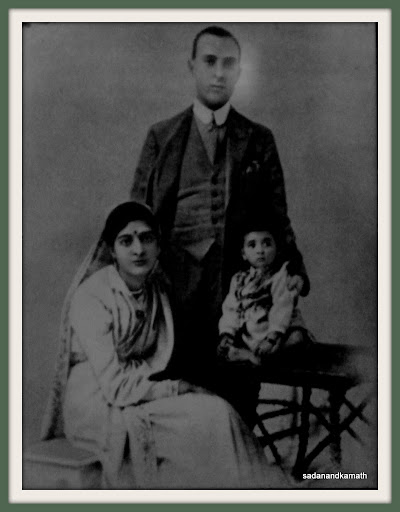 |
| A photo showing Jawaharlal Nehru with Kamla and Indira Gandhi as a kid on display in the museum. |
 |
| A heron on a railing at Allahabad railway station yard. |
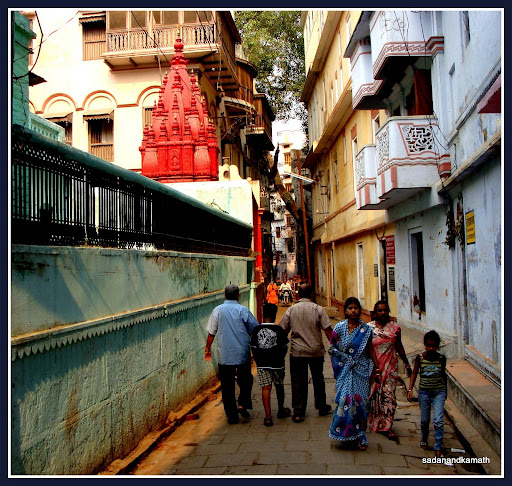 |
| One of the many narrow alleys for visiting Brahma Ghat in Varanasi. Compared with my visit in 2000, this time these alleys were clean devoid of cow dungs. |
 |
| Buddhist temple Mulagandhakuti Vihara at Sarnath |
 |
| Statue of Gautam Buddha in Malgundha Kuti Vihar temple, Sarnath. |
 |
| Murals inside Mulagandhkuti Vihara temple. |
 |
| One more murals inside Mulagandhkuti Vihara temple. |
 |
| On way to Dhamekh Stupa. When I visited this place in 2000, there was no entry fee for visiting this stupa. This time, the authorities have put railings for restricting entry by tourists. |
 |
| Dhamekh Stupa close up. The Stupa is 128 feet high with 93 feet in diameter. This is the spot where Gautam Buddha delivered his first sermon after attaining enlightenment. At the far end left is a Jain temple. |
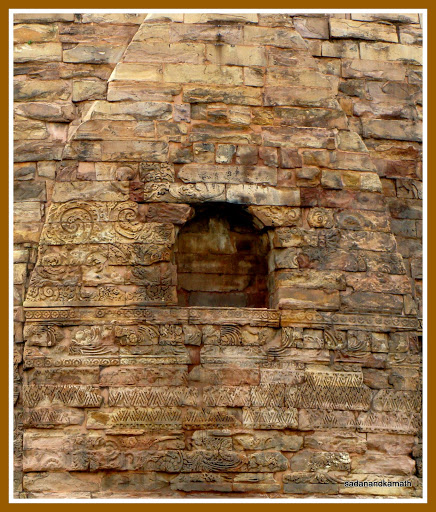 |
Incriptures on Dhamekh Stupa
|
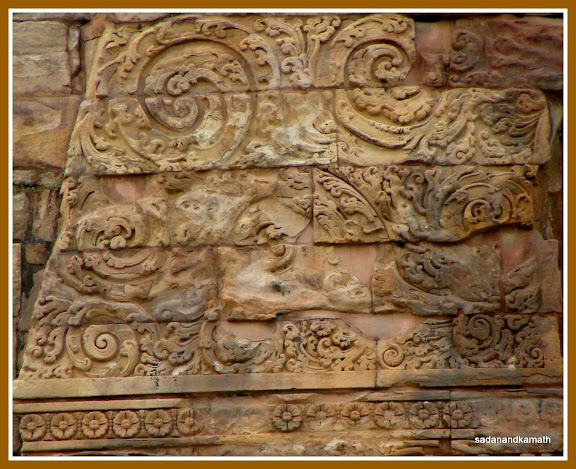 |
A close up of inscriptures on Dhamekh Stupa
|
 |
| A giant bell with inscriptions under a golden coloured arch near Mulagandhakuti Vihar temple in Sarnath. |
 |
| Buddha statue in a Chinese temple, Sarnath. |
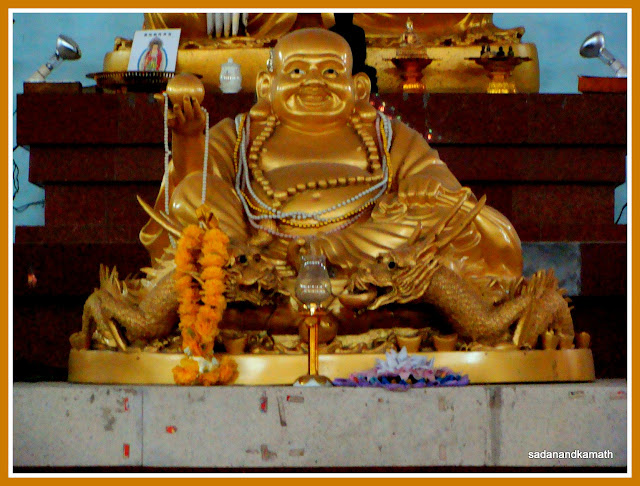 |
| Laughing Buddha in a Chinese temple, Sarnath. |
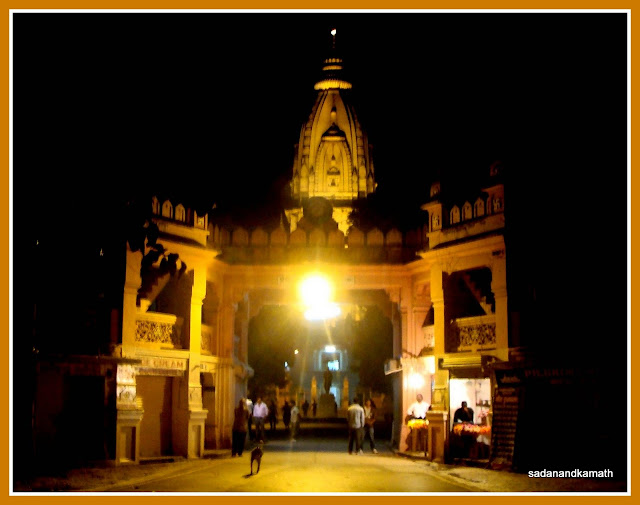 |
| A night shot of entrance to Birla temple in BHU compass. Photography inside this temple is not allowed. The main deity is Shiva in lingam form. |
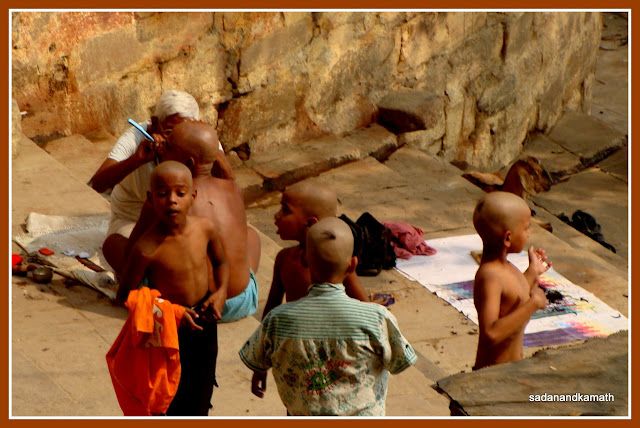 |
| A family undergoing mass mundan (freshly shaven head) ceremony at Brahma Ghat.caption |
 |
| Boats at Brahma Ghat waiting for pilgrims for Ganga river cruise. We paid Rs.440/- for a full boat (Rs.,40/- per head) for 3 hours boat trip from Brahma Ghat to Lalit Ghat and back. The boat was arranged by Kashi Math Sansthan where we stayed. |
 |
| Brahma Ghat. In the background is the Kashi Math Sansthan - one of the maths of Gowd Saraswat Brahmins where we stayed for conducting religious ceremony. |
 |
A wide angle shot of Jathar and Raja Gwalior Ghats with Aurangzeb's Mosque in the top background.
 |
Panchganga Ghat. In the background is Aurangzeb Mosque. On the right is Gokarn Partagali Jeevottam Math.
 |
| Zoom shot of Aurangzeb Mosque |
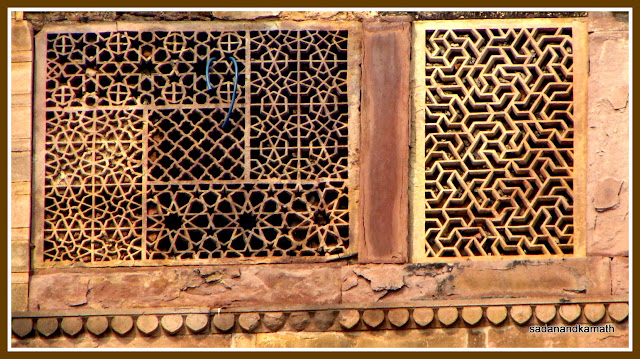 |
| A zoom shot of stone carved windows of a building near Jatar Ghat. |
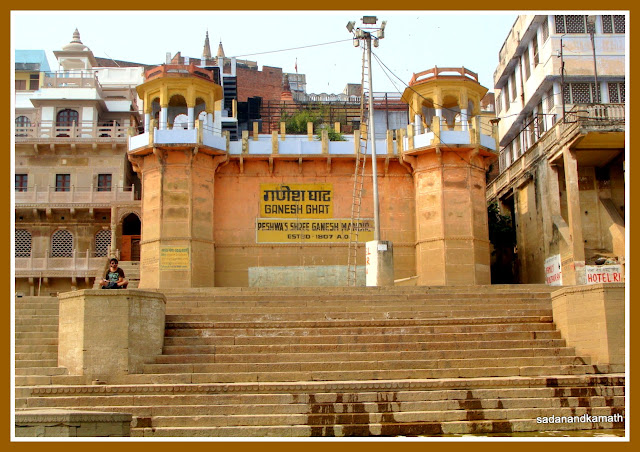 |
| Ganesh Ghat build by Peshwas in 1807. |
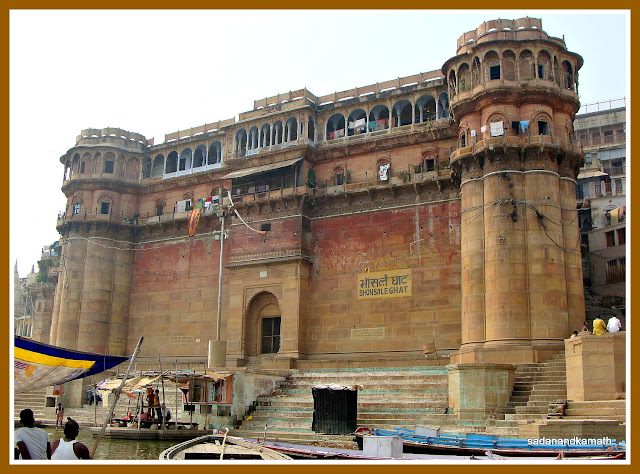 |
| Bhosle Ghat |
 |
| Open semi round balconies of Bhosle Ghat building. |
 |
| The submerged and tilted Shiva temple in front of Scindia Ghat. |
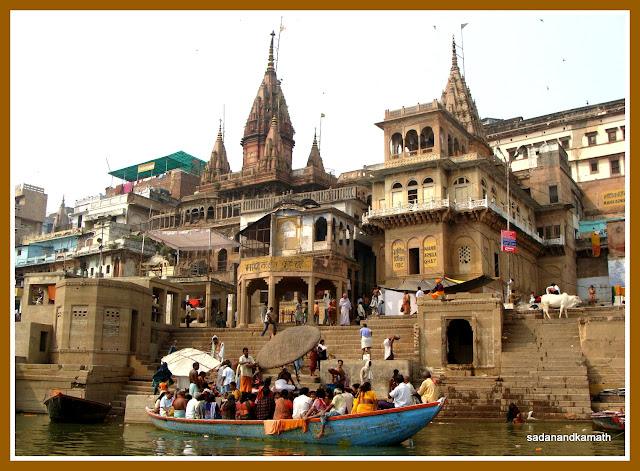 |
| Manikarnika Ghat |
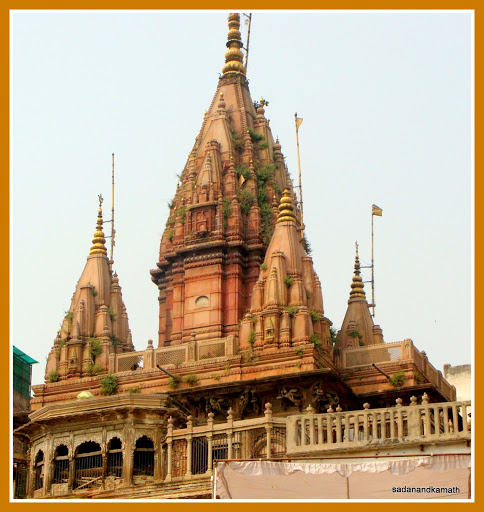 |
| A temple behind Manikarnika Ghat. |
 |
| The bamboo baskets hanging in front of a temple are in fact the lanterns which are lit in the night during the Hindu month of Kartik (Diwali month). |
 |
Funeral pyres burn almost through out the day at the creamation ghat near Manikarnika Ghat. Hindus believe that a cremation done here would lead to the moksha (escape the cycle of rebirth).
|
 |
| A boat carries wood for funeral pyre to the burning ghat. |
 |
| Lalit Ghat, also called Nepali Ghat where we alighted from the boat to walk down through alleys to Kashi Viswanath temple. This ghat was built by the King of Nepal. |
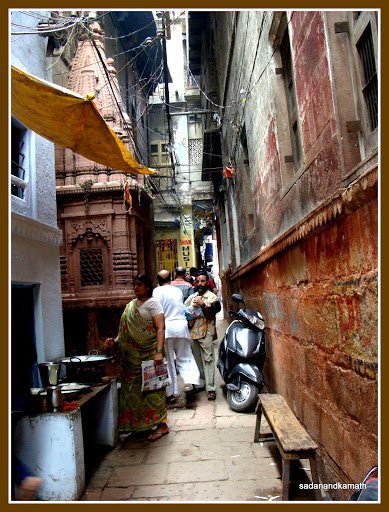 |
| A narrow path leading to Kashi Vishwanath temple. |
 |
| A snake charmer sitting in a alley leading to Kashi Vishwanath temple. |
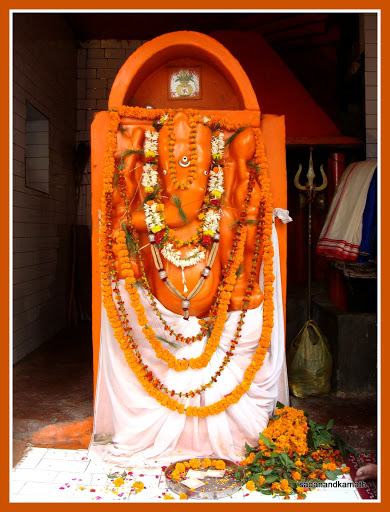 |
| Ganesh temple on way to Kashi Vishwanath temple. |
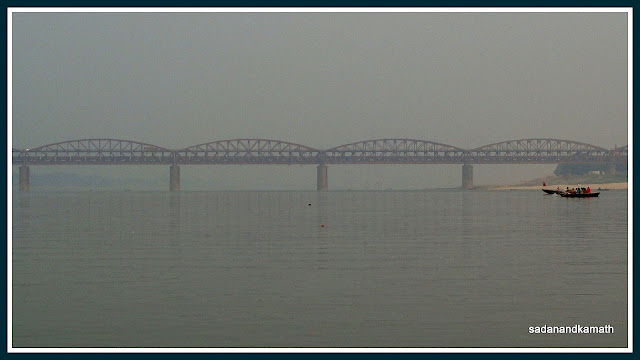 |
| A rail bridge over Ganga river. |
 |
| An unusual growth of Banyan tree trunk at Brahma Ghat gives an impression of Lord Ganesh's trunk |
13 comments:
SK: Wonderful Pictures all of them! Especially liked the ones of seagulls landing on Yamuna river and also the old B&W pictures of Nehru with bat and pads!
great post and informative also Varanasi Tour popularly known as Banaras is as important pilgrim city for Hindu, Buddhist and Jain religion. Varanasi tour is one of the top Tourist Destination in India. Varanasi is situated on the banks of river Ganga and the culture of this city is associated by Ganges due to its religious importance. Varanasi is the main center for religion and culture of North India from many thousand years. thanks for sharing...
A wonderful set of pictures providing a glimpse into this holy city !! Really lures you to visit it once. I recently visited the city and had a chance to go around witnessing the charm and spirituality.
To know about my experiences in the city, please do visit my blog post The Sangam City - Erstwhile Prayag - Allahabad
Thanks for sharing such kind of nice and wonderful collection......Nice post Dude keep it up. I have appreciate with getting lot of good and reliable and legislative information with your post......
Golden Triangle Tour Packages with Varanasi
Wonderful collections about these destinations. I love very much these places and visit here many times with my family. I like Varanasi very much. Thanks for sharing.
Post a Comment